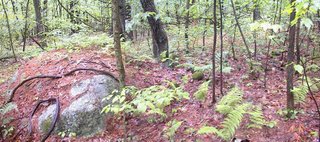This is a vertical flake with a rock next to it.
 Newcomers are not going to see anything in this and, in the past, I wouldn't have either. But as it occured in an area with numerous rock piles - a ceremonial area, and as I have seen this sort of thing before and had it pointed out enough times that I begin to credit it as a particular type of structure, I think I should pass it along. No clue about its meaning. The larger vertical rock has a notch in it like a gunsight.
Newcomers are not going to see anything in this and, in the past, I wouldn't have either. But as it occured in an area with numerous rock piles - a ceremonial area, and as I have seen this sort of thing before and had it pointed out enough times that I begin to credit it as a particular type of structure, I think I should pass it along. No clue about its meaning. The larger vertical rock has a notch in it like a gunsight.Speaking of gunsights:
 This split rock lines up almost accurately with a port-hole in the wall. It is not clear that it is designed with the intent of lining up with the hole in the wall. So this is just another thing to pass along. Look at these things not because they are a certainty but because they may be meaningful and we have to keep our eyes open to see what connects to what.
This split rock lines up almost accurately with a port-hole in the wall. It is not clear that it is designed with the intent of lining up with the hole in the wall. So this is just another thing to pass along. Look at these things not because they are a certainty but because they may be meaningful and we have to keep our eyes open to see what connects to what.Here is a nice pile.
 I haven't seen criss-crossed rocks like this before.
I haven't seen criss-crossed rocks like this before.Then, I was coming down off of the hilltop, a place with boyscout seats around a campfire ring, and I was walking along an old road of sorts, and passing a stone wall, and saw this scatter of rocks beside a boulder. This certainly could be from field clearing but I am still not sure. It is a nice looking pile either way.
 Then down near the eastern foot of the main hill there is a wetland with walls along its edge. Mavor & Dix calls this sort of large rock in a wall an "orthostat".
Then down near the eastern foot of the main hill there is a wetland with walls along its edge. Mavor & Dix calls this sort of large rock in a wall an "orthostat".
With the vertical split boulder, I am reminded of Nancy Bryant's article "Native American Stonework of Missouri on the NEARA website (www.neara.org/Bryant/missouri.htm.). She studied the same kind of feature, and there may be some connection between them.
ReplyDelete